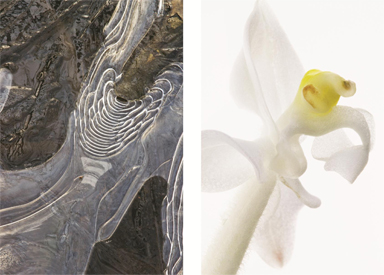Mary Leck’s “Flowers and Ice” On View at Chapin Gallery


ANGEL WINGS: As a trained botanist, Mary Allessio Leck combines a singular photographic eye for detail together with informed scientific knowledge. Shown here are her images of ice and water that will be included in the Gallery at Chapin’s “Parallel Views–Flowers and Ice,” through February 27, at the Chapin School, 4101 Princeton Pike. An opening reception for the artist is scheduled for tonight, Wednesday, February 4, from 5 to 7 p.m., but in case of inclement weather, visitors are advised to check for rescheduling details by calling (609) 924-7206 or visiting the Chaplin School website: www.chapinschool.org.
The Gallery at Chapin’s latest exhibition brings artistry and botanical science together for a close look at flowers and ice, the twin interests of local photographer Mary Allessio Leck. “Parallel Views – Flowers and Ice,” will run through February 27. An opening reception for the artist is scheduled for tonight, Wednesday, February 4, from 5 to 7 p.m., but in case of inclement weather, visitors are advised to check for rescheduling details by calling (609) 924-7206 or visiting the Chapin School website: www.chapinschool.org.
Ms. Leck appreciates water in all its forms. Known locally for her work with the freshwater wetlands once called the Hamilton-Trenton-Bordentown Marsh and now known at the Abbott Wetlands, Ms. Leck was among the founders of the Friends of the Marsh (www.marsh-friends.org). She is also a member of the Delaware and Raritan Canal Commission (DRCC), which overseas and manages the Delaware and Raritan Canal State Park and protects the streams that feed into the canal.
As a photographer she is drawn to both ice and flowers. Although these seem to be such separate subjects, one suggesting coldness and the other passion; one inanimate and the other living, “the properties of water underlie both,” explained Ms. Leck in a recent interview.
While the connection is obvious in the case of ice, it’s a little more subtle in the case of flowers. “As a scientist I’m interested in flowers right down to the level in which water is transported into the cells,” said the trained botanist who is a Rutgers University professor emerita. “My interests in flowers and ice run in parallel, both subjects have a great variety of forms, textures, colors, and patterns. Both are dependent on particular properties of water. Both can be extraordinarily beautiful. Both, also, can surprise and prove opportunities for discovery,” she said.
Her photography reveals forms in flowers as “simple” as a tulip or as complex as an orchid. Recent photographic explorations of flowers have yielded “enlightening” views “of the sparkle and wrinkled surfaces of petals, for example. Flowers can be deconstructed, petals removed to reveal inner details.”
Ms. Leck, who gained a bachelor’s degree in botany from the University of Massachusetts and a PhD in the subject from the University of Colorado in Boulder, is partial to photographing irises, orchids, and white flowers in general, but feels that all deserve a look.
When it comes to ice, Ms. Leck has found just as much diversity. She has discovered that ice can be textured. “The surface, bottom, and/or internal crystal formation is critical to determining what happens to light; sometimes the light pattern on the bottom of a puddle can create a complex mosaic superimposed on the leaves that collected there,” she has observed.
Photographing her two subjects combined with her deep scientific knowledge has enriched Ms. Leck’s awareness of the natural world and its myriad of connections: “I’ve come to realize that regardless of the subject, light is critically important to what I see (or that my camera captures). It is the properties of the cells and cell walls of flowers and features of ice crystal formation that determine whether light is transmitted, reflected, or refracted. Ultimately, it is the transparency of water to light that allows us to see, and to see patterns in ice or the pigments in petal cells.”
Her work draws upon the basic scientific techniques of observation and experimentation. “Underlying my photography is the fun of exploring, discovering, and trying to figure out explanations for what I’ve seen.”
Ms. Leck has participated in many shows including Phillips Mill Photography Exhibit, Grounds for Sculpture, Ellarslie at the Museum of Trenton, and D&R Greenway Land Trust.
The Chapin School is located at 4101 Princeton Pike, Princeton. The exhibition can be viewed during school hours by appointment. For more information, call (609) 924-7206, or email: sgomberg@chapinschool.org.

